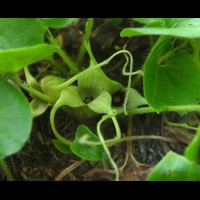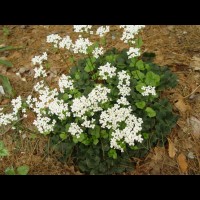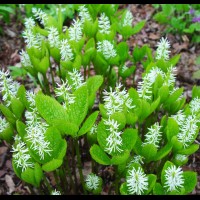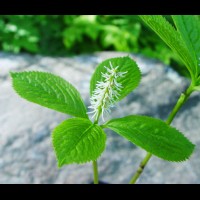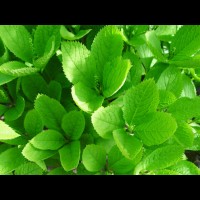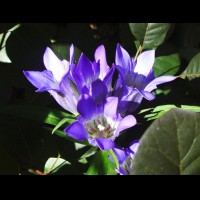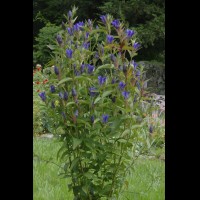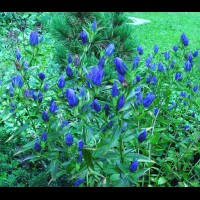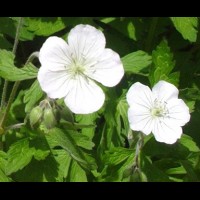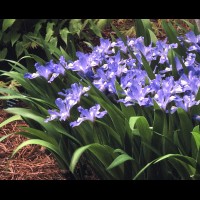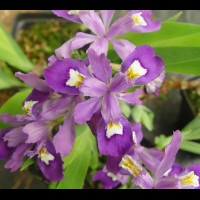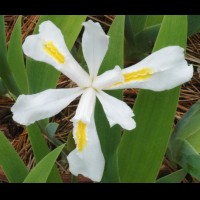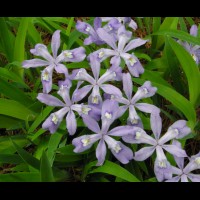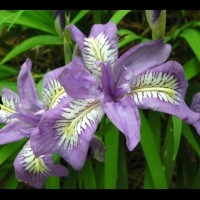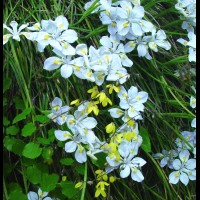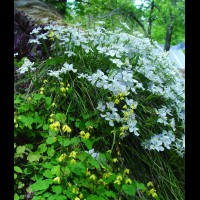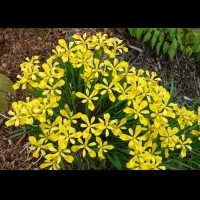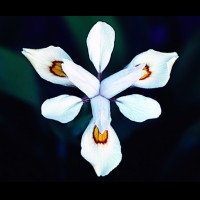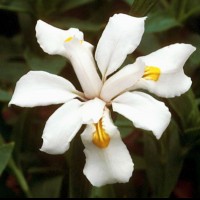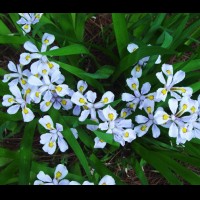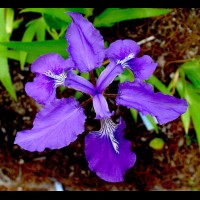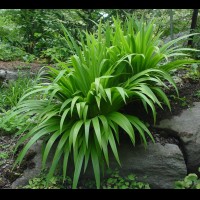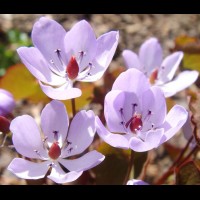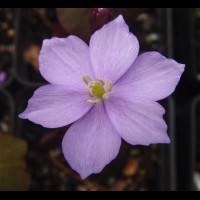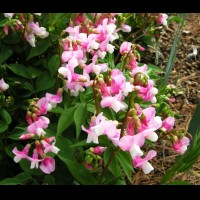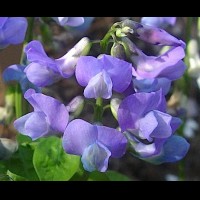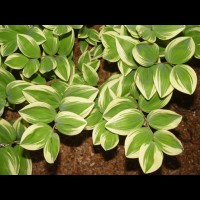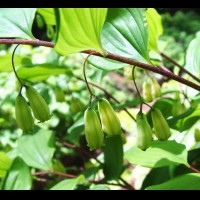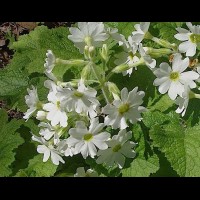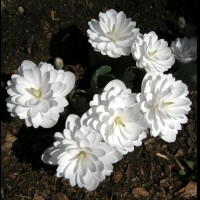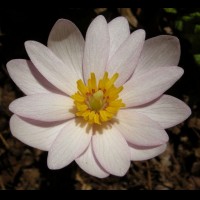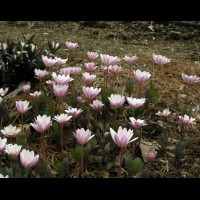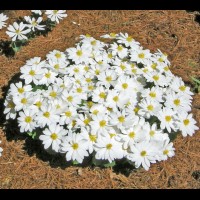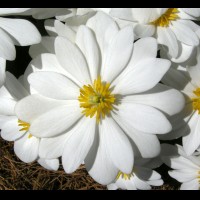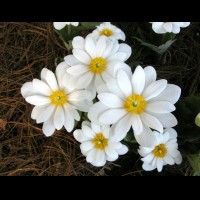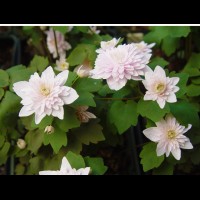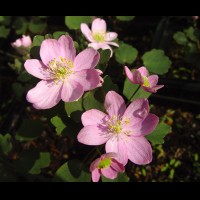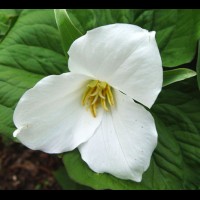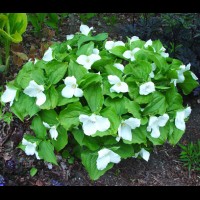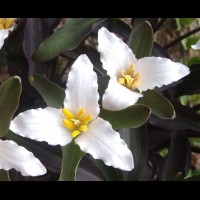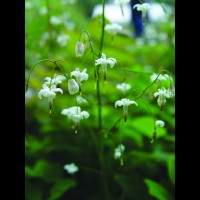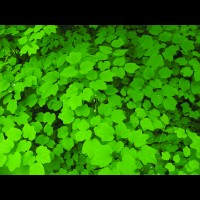These choice perennials all perform well in the same conditions as epimediums.
Asarum caudatum forma alba
Asarum caudatum f. alba
A "white” flowered form of this lovely West Coast native ginger. It thrives in partial shade, and moist, humus-rich soil, forming attractive colonies of large, lustrous, dark green, heart-shaped leaves 4” tall. Curious, creamy green flowers, each with three long tails, appear at the base of the plant in spring. This form is not commonly in cultivation and comes true from seed. Spreads by fleshy rhizomes 2-4" per year.
Cardamine trifolia "Japanese Cultivar"
Cardamine trifolia “Japanese Cultivar”
Beautiful, very low growing: 2-3” high, dense and tidy shade ground cover. Purchased in a Japanese garden shop by Barry Yinger with a name he could never find reference to. He believes it is a special selection. It is too nice of a garden plant to let that keep us from offering it.
Clouds of white cruciferous blooms hover 8-10” above the foliage on naked stems in mid-May. Deep evergreen trifoliate leaves with velvety purple undersides. Spreads slowly over time via 2” herbaceous rhizomes. Does best in bright to deep shade, in evenly moist, humus-rich soils. A favorite of mine.
Chloranthus japonicus
Chloranthus japonicus
Native to Japan and Korea. Easy to grow shade perennial with four corrugated leaves surrounding a white, bottle brush-like inflorescence. Bold, cup-shaped foliage lends interesting texture to the shade garden. Forms a small clump over time. 12-15” high.
Gentiana scabra
Gentiana scabra
An easy to grow, robust species for sun or partial shade (more shade where summers are hot). Tolerates a wide variety of soil conditions; blooms July-October. Native to northern Asia and Japan, this variable species sports erect, leafy erect stems 8 -15” high. Violet-blue, tubular upright facing flowers with 4 pointed corolla lobes. These plants are selected seedlings.
Gentiana x 'True Blue'
Gentiana x ‘True Blue’ (Plant Patent #20433)
***2008 Cobblewood Introduction***
Forms a well-branched, upright, robust column 24-36" high, by 12-18" wide, with lance-shaped leaves and 2” tubular caerulean blue flowers from midsummer-early fall. Best in part shade to full sun (in the north).
Plant in well-drained sandy loam/loamy soils with consistent moisture. A Darrell Probst hybrid. Propagation prohibited.
Geranium maculatum 'Cobblewood Ghost'
Geranium maculatum ‘Cobblewood Ghost’
This dainty woodland native bears white 1.5” blooms for 6-7 weeks in May-early June. Native to the eastern U.S. and Canada. Grows best in part shade to full sun. If planted in some sun, the dark green palmate leaves turn brilliant scarlet in fall. 2’ high by 18” wide. Darrell found this clone (far superior to the more commonly offered ‘Hazel Gallagher’) growing wild in central Massachusetts. Will naturalize in the garden from seed.
Iris cristata 'Edgar Anderson'
Iris cristata ‘Edgar Anderson’
Large flower form with periwinkle blue falls that darken below the diffused signal ring. Wide white signals bordered in a dark blue ring. 6.5” in bloom with two 2-1/4” flowers per stem. This selection has outstanding vigor, good substance, spreads quickly. An early bloomer.
Iris cristata 'Little Jay'
Iris cristata 'Little Jay'
A beautiful blue form of Iris cristata from Iris breeders Marty Shafer and Jan Sacks of Joe Pye Weeds Garden in Carlisle, MA. The blue and white crest saturates the flower with color. 4.5" tall in bloom. Vigorous spreader.
Iris cristata 'Merle's Ruby'
Exceptional for its red-violet rather than the typical blue-violet flower color, very rare in crested iris. This clone was discovered in the wild in North Carolina by a woman named Merle. It was sold for several years by Rice Creek Nurseries, but is not common in the trade. A vigorous grower and a heavy-bloomer. Recently registered with the AIS by Joe Pye Weed’s Garden in Carlisle, MA.
Iris cristata 'Montrose White'
Iris cristata ‘Montrose White’
***2010 Joe Pye Weed's Garden Introduction***
A showy, strong-growing, clean white form, originally from Nancy Goodwin at Montrose Nursery. Its large, nearly 3” diameter flowers are unique among the “albas”. Grows to 6” tall. Spreads 2-4" per year. (Photo courtesy of Jan Sacks)
Iris cristata 'Sam's Mini'
Iris cristata ‘Sam’s Mini’
***2006 Joe Pye Weed's Garden Introduction***
Another treasure from Sam Norris, collected by Sam in Olive Hill, Kentucky. A “mini” at only 3-1/2” in height, it has similarly small flowers and compact foliage. Over several years, it forms large dense mats with many bloom stalks. The flowers have a soft appearance and are medium blue-violet with white signals, yellow and white crests with a slightly darker blue-violet halo (Photo courtesy of Jan Sacks)
Iris gracilipes
Requiring similar woodland conditions as Iris cristata, this enchanting Japanese native forms small clumps of arching grassy leaves 6-8” tall. In late May/early June numerous small, 1-1/2” wide violet-lavender flowers terminate thin, wiry stems just above the leaves. Large white signal trans-versed with violet-lavender veins. Small orange crest. Leaves eventually grow to 8” long.
Iris dabashanensis
Iris dabashanensis (Several clones)
(formerly sold under the name Iris henryi)
A newly named Iris species collected by Darrell Probst in N.E. Sichuan Province. Belongs to the same Chinensis section of the genus Iris as I. koreana and odaesanensis, but is very different. Best in bright shade/half-sun and in rock gardens. Forms a 12” by 2’ clump of evergreen, grassy foliage 1/8” wide. In mid-spring, numerous 6” stems emerge, each bearing two 1”+ palest lavender Iris flowers with a small, yellow signal. Pictured here in combination with Epimedium platypetalum.
Iris koreana 'Firefly Shuffle'
Iris koreana ‘Firefly Shuffle’
***2010 Cobblewood Introduction***
A very floriferous clone of this Asian species iris, and a good grower. Mid May is heralded with the annual explosion of sunny, bright lemon yellow blossoms covering the plant. Great for the rock garden. Best in bright shade or a few hours of direct sun, it forms a grassy-leaved clump that slowly spreads into a “patch”. Semi-evergreen.
Iris odaesanensis
Iris odaesanensis
Pristine white flowers with a yellow signal edged in a thin, brown halo. Two flowers, each nearly 2” in diameter, are borne atop 8” stems in late May. Semi-evergreen leaves expand after bloom to reach 12” long, 1/2” wide, forming dense clumps of arching foliage. Prefers a little more sun than Epimediums. This clone was originally collected on Odaesan in Korea by Darrell Probst in 1997.
Iris odaesanensis Chuwangsan #3
Iris odaesanensis “Chuwangsan #3”
I. odaesanensis was previously known to exist only on the top of Odae-san (san = mountain). To the surprise of his Korean host from Chollipo Arboretum, Darrell found a few pockets of it growing on a wooded rocky ledge on Chuwangsan, 100 miles south of Odaesan. He collected three unique clones.
The flowers of this vigorous grower lack the typical brown halo surrounding the signal. It also seems to be less tasty to the local slugs. Semi-evergreen.
Iris odaesanensis 'Ice Whisper'
An icy-blue lavender-flowered variant of this normally white-flowered species. Darrell collected a pale lavender-flowered clone in Korea, and grew seed from that plant. This is his deepest lavender-flowered selection.
Semi-evergreen leaves grow to 12" after bloom, forming dense clumps of arching foliage. Half to full sun exposure.
Iris tectorum 'Slippery Slope'
Iris tectorum ‘Slippery Slope’
***2010 Cobblewood Introduction***
Darrell has failed endless times growing the Japanese roof iris in our climate. The flower buds die over winter, starting a rot that eventually kills the plant. He collected this much hardier clone at a high elevation in the Dabashan region of southern Shaanxi Province, China. Here they were pulled up and over the icy mountain by a coal truck in Nov. 2000, hence the cultivar name.
This clone thrives in half sun on an exposed stony ridge in my garden. Best with sharp drainage in light shade/part sun. Large 4” violet blossoms emerge in late spring from 2’ × 2’ bright green foliage fans, giving a tropical appearance to an otherwise New England perennial garden. Spreads slowly, 2-5". per year, by fleshy rhizomes to form a massive clump over time, so give it some elbow room! Needs division every 3-4 years for maximum vigor.
Jeffersonia dubia "Dark Centers"
Jeffersonia dubia “Dark Centers”
Name change to: Plagiorhegma dubia "Dark Centers", but I can't bring myself to call it that.
This plant provides a pop of welcome early spring color as soon as the ground thaws. New leaflets emerge a rusty brown color to contrast with the periwinkle blue/lavender petals. A cranberry colored ovary and dark purple/black anthers add to its charm. These plants are seedlings from plants Darrell collected in the wild in Korea.
Jeffersonia dubia "Putnam's Blue"
Name change to: Plagiorhegma dubia "Putnam's Blue", but I can't bring myself to call it that.
The Asian Twinleaf is a choice perennial that any “real” garden can’t be without, and the more, the better. It blooms very early in spring, usually starting a couple of weeks before the epimediums. Its flowers fade quickly if the suddenly weather heats up. Flowers of "Putnam's Blue" open a deep blue-lavender, and fade with age. The blossoms seemingly float above the rounded, wavy-edged, almost waterlily-like leaves.
Plants bloom at about 4-6” tall, each leaf expanding to 2-3” or so across eventually forming a dense clump 8-10” tall. This selection has the same rusty-red new growth in spring, but is deeper blue-lavender in bloom than ‘Dark Centers’ with a green ovary and longer, fatter, sculpted petals. These are seed grown as Jeffersonia defies division. It originally came from Bob Putnam’s nursery via Jim Jones.
Lathyrus vernus 'Albo-roseus'
Lathyrus vernus ‘Albo-roseus’
Another tough, long-lived perennial native to Europe for either full sun or partial shade. It tolerates many situations and is a good foliage plant throughout the season. Showy racemes of bi-colored pink and white pea-like flowers in earliest spring, on neat clumps to 18”. Leaves pinnately compound. Easy to grow and long-lived. (Photo by Jan Sacks)
Lathyrus vernus 'Katrink Hull'
Blue-flowered Perennial Sweet Pea
***2011 Cobblewood Introduction***
Selected as the best from a few “blue flowered” seedlings of the perennial sweet pea in the former garden of our late friend and accomplished rock gardener Katrink Hull. Flowers are an amazing caerulean blue mixed with shades of violet blue. Vigorous growing and free flowering. Best in bright shade or a few hours of sunlight per day. Handsome green pinnate foliage (typical of the pea family) on a 12-15" high plant in summer/fall. Blooms along with the earliest Epimediums.
Phlox stolonifera 'Wister Pink'
Phlox stolonifera 'Wister Pink'
A dusky pink form of this easy to grow native plant, not commonly available in the trade. The rounded leaves form a thick groundcover 2-3" high, above which the large flowers bloom in mid-May in Massachusetts. 6-8" tall in bloom. Spreads by 6-8" runners. Semi-evergreen.
Polygonatum odoratum 'Carlisle'
Polygonatum odoratum ‘Carlisle’
A brilliantly variegated Japanese Solomon Seal with much wider white margins than are typical, and a slightly shorter stature-18-20”. The stems also have a slight red tint. Spreads slowly, by 2-5" rhizomes, making an excellent, showy groundcover. Great for brightening up dark spaces in the shade garden.
Polygonatum omeiense
Polygonatum omeiense
A charming Asian Solomon’s Seal from Sichuan Province, China. This attractive, low groundcover features fat, greenish-white, capsule-shaped blossoms in pairs in mid-early June in Massachusetts. Its arching stems are speckled with purple-brown and hold the undulating leaflets, giving textural interest to the garden. 12 to 15” high. Spreading rhizomes grow 2-3” per year.
Primula kisoana forma alba
Primula kisoana f. alba
The white-flowered form of this spreading Japanese woodland primrose. Downy, scalloped light green foliage is very different from other Primulas. Great as a low ground cover planted at the base taller woodland plants. Clusters of white flowers in mid-May. Prefers evenly moist, humus-rich soils. 4-6” high. Spreads by rhizomes of varying length to form extensive, thick colonies over time.
Sanguinaria canadensis 'Multiplex'
Double-flowered Bloodroot
Elegant double form of the native bloodroot. The full, white, multi-petaled flowers and glaucous foliage resembles a pool of waterlilies in the spring garden. Spreads by fleshy underground rhizomes to form large colonies over time. Best in light shade. This double-flowered form blooms for a considerably longer period than the more fleeting, fertile, single-flowered forms. (Photo by Jan Sacks, Joe Pye Weed's Garden)
Sanguinaria canadensis 'Venus'
Sanguinaria canadensis 'Venus' formerly “Pink Form”
In earliest spring, the buds of this native shade-loving Bloodroot variant emerge a deep pink. The showy wide-petaled flowers open light pink, and fade to shell pink. Dark pink stems on both leaves and flowers. The reverse sides of the petals remain a darker pink, repeatedly displaying their rich pink blush when they close each evening. Gradually spreads by thick fleshy rhizomes, 2-6" per year, to form a large colony over time.
Sanguinaria canadensis 'Snow Cone'
Sanguinaria canadensis 'Snow Cone'
***2016 Joe Pye Weed's Garden Introduction***
A long awaited superior form selected from Sanguinaria canadensis ‘Tennessee Form’ seedlings. Each clean, white flower has 18 to 25 petals, and is 3+ inches across. A strong grower, it quickly forms a dense, prolifically flowered clump, spreading by thick, fleshy rhizomes, 2-6" per year. Blooms for a longer time than the fleeting native form. 5-5.5” tall in bloom, to 12”. It is fertile and produces seed. This clone also seems to holds its foliage longer than the other types before going dormant in summer. A true beacon of white in the early spring garden.
Sanguinaria canadensis "Tennesee Form"
Sanguinaria canadensis “Tennessee Form”
Our native Bloodroot flowers sport a single row of eight petals, whereas this form from Tennessee has at least two rows for a total of sixteen. The flowers, some reaching 3-1/4” across, cover the foliage. The interior row of petals is slightly narrower and 1/4” shorter creating a showy semi-double flower. 5-6” tall in bloom with deeply incised leaves. To 12” Spreads by thick, fleshy rhizomes, that grow 2-4" long annually. (Photos by Jan Sacks, Joe Pye Weed's Garden)
Thalictrum (formerly Anemonella) thalictroides 'Cameo'
Thalictrum thalictroides 'Cameo' (try saying that quickly, several times in a row!)
This easy-to-grow, ephemeral spring Rue Anemone produces sterile blooms over a long period in spring. Delicate, double flowers of the palest pink top the short 5-6” plants. Typically goes dormant in early summer, so mark the space it occupies, so you don’t crowd it out with other additions to the garden in its absence. Site in well-drained soils in bright shade for best results.
Thalictrum (formerly Anemonella) thalictroides 'Pink Pearl'
A cheerful, easy to grow, and long-lived, but hard to find introduction from Mt. Cuba Center in Wilmington, DE. Bright, lavender-pink up facing flowers, 1” in diameter appear with the earliest of spring wildflowers. The 6” high, Columbine-like foliage fades into dormancy by mid-summer. Prefers a bright shade location in moist, but well-drained soils. Introduced in 2007, but rare in the trade.
Trillium grandiflorum "Trina's Wisconsin Clone"
Trillium grandiflorum “Trina’s Wisconsin Clone”
***2017 Cobblewood™ Introduction***
A native trillium that I have grown for years. I was encouraged by plantsman Mark McDonough to offer it for its full rounded flower form. This lime-loving species is easy to grow forming large, blowsy, floriferous clumps. One of the most coveted plants at my Open Nursery Days. Given to me by my gardening friend Trina Van Cura. She brought it with her when she moved from Wisconsin. Reaches 15 to 18”.
Trillium pusillum 'Roadrunner'
Trillium pusillum ‘Roadrunner’
***2007 Joe Pye Weed's Garden Introduction***
Trilliums are notoriously slow to propagate. While this diminuitive species propagates faster than most, this clone grows particularly rapidly, making a substantial, floriferous clump in just a few years. Trillium pusillum is native to S.E. United States west to Oklahoma. New spring leaves emerge dark purple, almost black, and remain so as the 1-1/2” white, tri-petaled flowers open. It begins bloom at 4", with the foliage eventually reaching 12" tall. Foliage usually goes dormant and disappears by summer's end. Each petal has a rosy reverse. Foliage matures to green as the flowers blush to pink as they age.
Vancouveria hexandra
Vancouveria hexandra (Several Cc.)
A west coast native, and also a later-blooming relative to Epimedium. This fine-textured, low-growing groundcover sports leaflets reminiscent of “duck’s feet” to 6” high, with flower stems to 15”. Blooms about a month later than do Epimediums, producing numerous small, pendulous white flowers, similar to those of Epimedium, but with six flower parts instead of four. Very drought tolerant and an excellent ground cover for deep shade. Spreads vigorously by thin, 6-10" underground rhizomes. Rumored not to thrive in the deep south.
